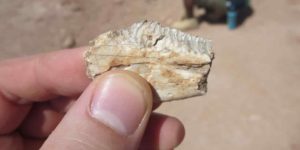
A new study by University of Alberta paleontologists shows that one type of ancient reptiles evolved a special type of tooth enamel, similar to that of mammals, with high resistance to wear and tear.
The reptile—known as Priosphenodon—was a herbivore from the Late Cretaceous period that was about one metre long. Part of a group of reptiles called sphenodontians, they had the unique trait of adding new teeth to the back ends of their jaws instead of replacing them where they fell out.
“Priosphenodon has the strangest teeth I have personally ever seen,” said Aaron LeBlanc, a post-doctoral fellow in biological sciences and lead author on the study. “Some aspects of their dental anatomy are reminiscent of what happened in the evolution of early mammal teeth.”
The specimens were found in Argentina’s Río Negro province as part of ongoing collaborative fieldwork and research between U of A paleontologist Michael Caldwell and Argentinian paleontologist and fieldwork leader Sebastián Apesteguía.
To look closely at the teeth of Priosphenodon, the researchers cut open pieces of jaw and examined tissue-level detail preserved inside the teeth, and used non-invasive CT scans to examine more complete jaw specimens.
“Priosphenodon enamel is not only thicker than that of most other reptiles, the enamel crystals are ‘woven’ into long threads that run through the whole width of the enamel. These threads are called enamel prisms, and they are almost exclusively found in mammals,” said LeBlanc, who is working under Caldwell’s supervision.
“Our results suggest that strong selective pressures can force reptiles to come up with some very innovative solutions to the problems associated with tooth wear and abrasive diets—some of which mirror what happened in our earliest mammal ancestors.”
The scientists also noted there is one kind of lizard alive today that has prismatic enamel like Priosphenodon—the spiny-tailed lizard of Australia. Like Priosphenodon, it mostly eats plants and has lost the ability to replace its worn teeth. However, the two reptiles are not closely related.
Hans Larsson from McGill University also collaborated on the study, which was funded by the Agencia Nacional de Promoción Científica y Tecnológica in Argentina, National Geographic and the Natural Sciences and Engineering Research Council of Canada.
The study, “Unique Tooth Morphology and Prismatic Enamel in Late Cretaceous Sphenodontians from Argentina” was published in Current Biology.
Reference:
Aaron R.H. LeBlanc et al. Unique Tooth Morphology and Prismatic Enamel in Late Cretaceous Sphenodontians from Argentina, Current Biology (2020). DOI: 10.1016/j.cub.2020.02.071
Note: The above post is reprinted from materials provided by University of Alberta.










